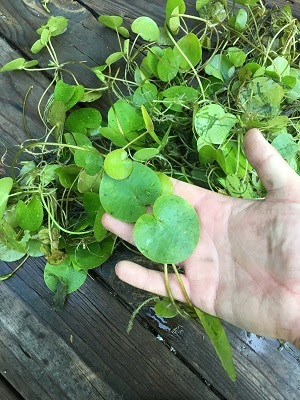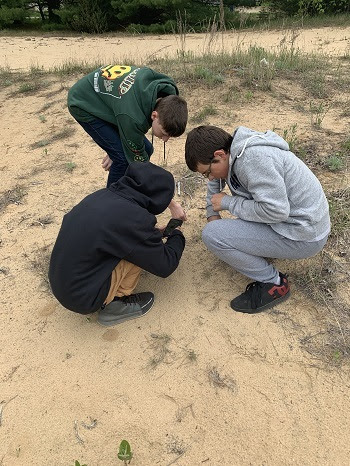| Feb. 1, 2024
Contact: Joanne Foreman, 517-284-5814
From now until summer, the NotMISpecies webinar series is devoting (most of) its time to showcasing the results of important work by Michigan Invasive Species Grant Program grantees. Projects include outreach in classrooms and by the boating industry and new research on controlling European frog-bit and invasive knotweeds.
The series also features an update on efforts to control invasive hydrilla, detected for the first time in Michigan in 2023.
Since 2014, the program – a joint effort of the Michigan departments of Natural Resources; Environment, Great Lakes, and Energy; and Agriculture and Rural Development – has awarded at least $3.6 million per year to prevent, detect, eradicate and control terrestrial and aquatic invasive species.
Grants support regional and statewide outreach, survey and control efforts and research to improve detection and management of new and established invasive species.
Frog-bit findings
 European frog-bit was first detected in southeast Michigan in 1996 and has since spread along the coastal areas of lakes Erie, Huron and Michigan and to some inland lakes. Kevin Kapuscinski, associate professor and assistant director of research at Lake Superior State University’s Center for Freshwater Research and Education, has been studying the aquatic invasive plant and its effects on native ecosystems and water quality since 2019. European frog-bit was first detected in southeast Michigan in 1996 and has since spread along the coastal areas of lakes Erie, Huron and Michigan and to some inland lakes. Kevin Kapuscinski, associate professor and assistant director of research at Lake Superior State University’s Center for Freshwater Research and Education, has been studying the aquatic invasive plant and its effects on native ecosystems and water quality since 2019.
In “What’s the Damage? Ecology and Effects of Invasive European Frog-bit in the St. Marys River” (9 a.m. Wednesday, Feb. 7), he will share what’s been learned about plant reproduction, removal efforts and impacts based on research in the St. Marys River in the Upper Peninsula. |
Industry initiative
After trailering boats, and before getting on the road, Michigan boaters are required to pull plugs, drain water and remove plants and debris, but many have been slow to comply with the 2019 law. In 2021, the Michigan Boating Industries Association got on board with state efforts to help boaters understand their role in stopping the spread of aquatic invasive species. With help from the Michigan Invasive Species Grant Program, MBIA launched its Boaters Prevent AIS initiative.
Join MBIA’s Amanda Wendecker for “I Wash My Bottom, Do You? Engaging the Boating Industry in AIS Prevention” (9 a.m. Thursday, March 21) to learn how an industry push, along with an eye-catching campaign, has helped engage thousands of boaters across the state.
New knotweed knowledge
Invasive knotweeds are a growing problem throughout Michigan. In the Upper Peninsula, a collaborative effort is underway to find the best methods for detecting and managing these aggressive plants.
In “Untangling the Knot: Identifying Effective Detection and Treatment Regimens for Invasive Knotweeds” (9 a.m. Thursday, April 11) Dorthea Vander Bilt of Michigan Tech Research Institute at Michigan Technological University, Sigrid Resh of the Keweenaw Invasive Species Management Area and MTU, and Matt Watkeys of Alger Conservation District will share the results of their recent research. The team studied various chemical, manual and integrated control methods on Japanese, Bohemian and giant knotweed species and employed remote sensing to detect and prioritize knotweed populations across the landscape.
Halting hydrilla
 The mythic Hydra was a water serpent that sprouted two heads for every one cut off. In a similar fashion, hydrilla – said to be the most invasive aquatic plant in the world – can grow new plants from stem fragments, making it a formidable challenge to control. The mythic Hydra was a water serpent that sprouted two heads for every one cut off. In a similar fashion, hydrilla – said to be the most invasive aquatic plant in the world – can grow new plants from stem fragments, making it a formidable challenge to control.
That challenge now faces Michigan, where hydrilla was recently detected for the first time. In “A Herculean Task: Containing the First Hydrilla Infestation in Michigan” (9 a.m. Tuesday, May 21), Billy Keiper from EGLE Water Resources Division explains why hydrilla is such a threat, how the Michigan Invasive Species Program is working to eradicate it, and how you can help identify and report it. |
Student stewardship
 If you’re looking for a successful model for infusing invasive species education into the classroom, Lake Superior State University’s Beth Christiansen has one. For the last three years, she’s been bringing together students, teachers, natural resource mentors and staff from LSSU’s Center for Freshwater Research and Education to conduct hands-on research into local invasive species issues. If you’re looking for a successful model for infusing invasive species education into the classroom, Lake Superior State University’s Beth Christiansen has one. For the last three years, she’s been bringing together students, teachers, natural resource mentors and staff from LSSU’s Center for Freshwater Research and Education to conduct hands-on research into local invasive species issues.
In “Invading Classrooms: Empowering Students to Take Action on Invasive Species” (9 a.m. Tuesday, June 25) Christiansen will share the story of how collaboration has fostered local, student-led stewardship projects to raise awareness and inspire action in communities across northern Michigan. |
How the webinars work
Monthly webinars from the Michigan Invasive Species Program provide an inside look at efforts across the state to prevent the introduction and spread of invasive plants, insects, animals and diseases.
Each hourlong session introduces experts with hands-on experience in invasive species research, management and prevention, who provide current information on threats to Michigan’s land and water. Question-and-answer sessions and links to resources help attendees get the most out of each presentation.
More grant projects
Additional NotMISpecies webinars focused on grant-funded projects, including biocontrol for invasive swallowworts and knotweeds, managing phragmites and hemlock woolly adelgid, and the work of Michigan’s 22 cooperative invasive species management areas, can be viewed by visiting the webinar’s archives on the NotMISpecies webpage.
Michigan’s Invasive Species Program, a collaborative effort of the Michigan departments of Natural Resources; Environment, Great Lakes, and Energy; and Agriculture and Rural Development, coordinates and supports invasive species initiatives across the state and provides support through the Michigan Invasive Species Grant Program.
/Note to editors: Accompanying photos are available below for download. Caption information follows.
EFB plant: European frog-bit, an invasive aquatic plant, is now widely distributed in shallow-water areas of Michigan’s eastern shoreline.
Hydrilla: Invasive hydrilla, visible here as the larger, spiked plants protruding from or just under the water, has been found in two private ponds in southwest Michigan.
Pellston survey: Students take part in a plant survey near their school in Pellston, Michigan./ |

